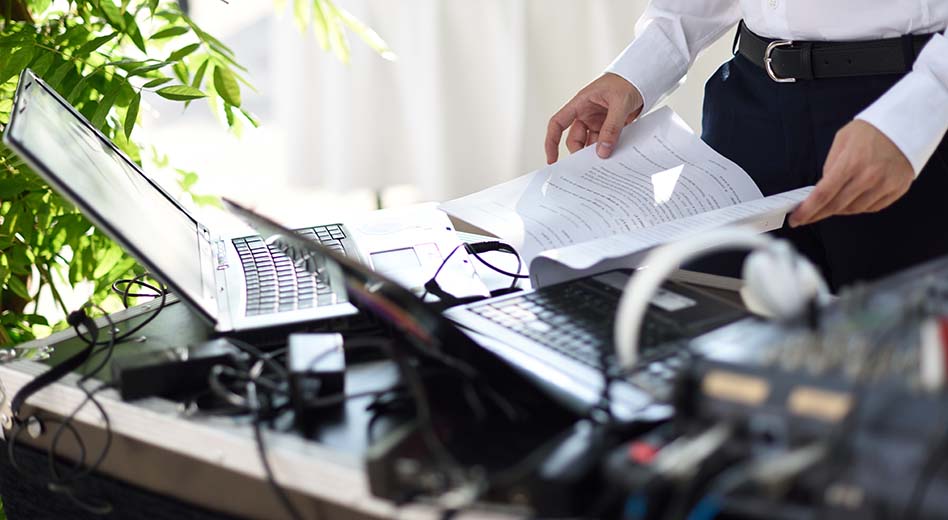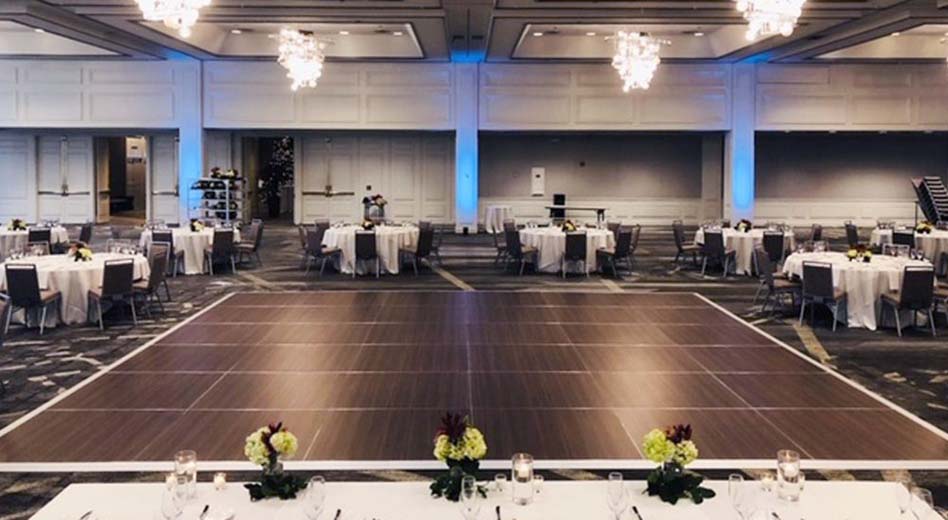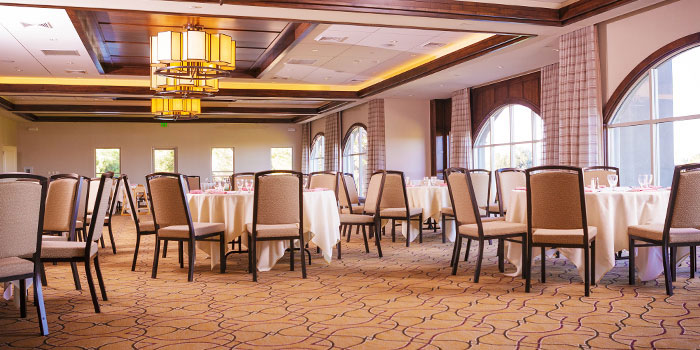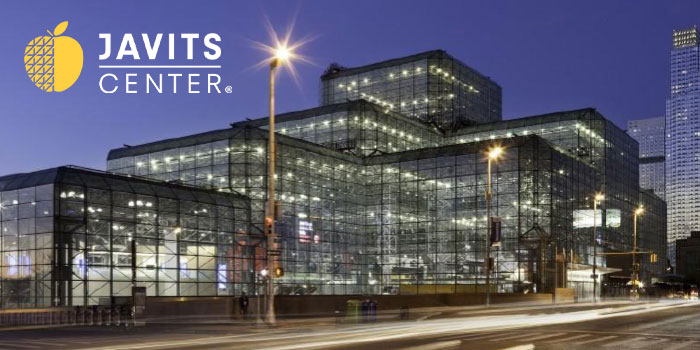
Wenn Sie für Veranstaltungen an Ihrem Veranstaltungsort eine tragbare Tanzfläche verwenden, haben Sie die Flexibilität, die Größe der Tanzfläche an jede Veranstaltung anzupassen. Hochzeitsempfänge, Firmengalas, Wohltätigkeitsbälle und andere Veranstaltungen erfordern unterschiedliche Raumaufteilungen und unterschiedliche Gästezahlen. Dies wiederum wirkt sich auf die ideale Größe der Tanzfläche aus.
Unser Team bei MityLite® hat diese zuverlässige Tanzflächengrößen-Rechnertabelle zusammengestellt, damit Sie jedes Mal die perfekte Veranstaltung planen können. Wir erläutern auch die verschiedenen Elemente, die Sie berücksichtigen sollten, wenn Sie überlegen, wie groß die Tanzfläche für jede Veranstaltung sein muss.
Berechnung der Tanzflächengröße
Mit modularen Tanzflächen-Kits können Sie für jede Veranstaltung genau die richtige Tanzfläche einrichten. So vermeiden Sie die Unannehmlichkeit einer fast leeren Tanzfläche oder die Unannehmlichkeit eines überfüllten Tanzbereichs.

Bei der genauen Einschätzung der für verschiedene Veranstaltungen benötigten Tanzflächengröße spielen mehrere Faktoren eine Rolle. Sehen wir uns also die einzelnen beteiligten Variablen an.
Wie viele Gäste werden tanzen?
In den meisten Fällen tanzen maximal 50% Gäste bei einer Veranstaltung zu einem bestimmten Zeitpunkt. Um herauszufinden, wie viel Platz auf der Tanzfläche benötigt wird, muss man daher zunächst die maximale Anzahl der erwarteten Gäste kennen. Wenn bei einer Veranstaltung im Laufe des Abends eine unterschiedliche Anzahl von Gästen vorbeikommt, kann diese Zahl auf die maximale Anzahl von Gästen pro Stunde reduziert werden. Überlegen Sie dann, welche Art von Tanz stattfinden wird, um eine Vorstellung davon zu bekommen, wie viel Platz jede Person auf der Tanzfläche benötigt.
Wir haben diese hilfreiche Umrechnungstabelle für Tanzflächengrößen erstellt, um Ihnen eine Vorstellung davon zu geben, wie sich die Quadratmeterzahl normalerweise in die Anzahl der Tänzer aufteilt, die auf der Tanzfläche Platz finden.
Bodengrößen-Kit | Anzahl der Panels | Anzahl der Tänzer | Anzahl der Wagen (im Kauf enthalten) |
|---|---|---|---|
8′ x 12′ | 6 | 26 | 1 |
8′ x 16′ | 8 | 34 | 1 |
12′ x 12′ | 9 | 38 | 1 |
12′ x 16′ | 12 | 50 | 1 |
12′ x 20′ | 15 | 62 | 1 |
16′ x 16′ | 16 | 66 | 1 |
16′ x 20′ | 20 | 82 | 1 |
16′ x 24′ | 24 | 98 | 1 |
16′ x 28′ | 28 | 114 | 2 |
16′ x 32′ | 32 | 130 | 2 |
20′ x 20′ | 25 | 102 | 1 |
20′ x 24′ | 30 | 122 | 2 |
20′ x 28′ | 35 | 142 | 2 |
20′ x 32′ | 40 | 162 | 2 |
24′ x 24′ | 36 | 146 | 2 |
24′ x 28′ | 42 | 170 | 2 |
24′ x 32′ | 48 | 194 | 2 |
24′ x 36′ | 54 | 218 | 3 |
28′ x 28′ | 49 | 198 | 2 |
28′ x 32′ | 56 | 226 | 3 |
32′ x 32′ | 64 | 258 | 3 |
32′ x 36′ | 72 | 290 | 3 |
36′ x 36′ | 81 | 326 | 4 |
36′ x 40′ | 90 | 362 | 4 |
40′ x 40′ | 100 | 402 | 4 |
Wie Sie sehen, bietet eine Tanzfläche mit den Abmessungen 2,44 m x 3,66 m Platz für ungefähr 26 Personen, während auf einer Tanzfläche mit den Abmessungen 121 m x 121 m bis zu 402 Personen gleichzeitig Platz finden.
Welche Größe sollte meine Tanzfläche haben?
Jede Art von Veranstaltung bringt einzigartige Herausforderungen hinsichtlich Design und Layout mit sich, die Ihnen letztendlich dabei helfen können, den für die Einrichtung Ihrer Tanzfläche verfügbaren Platz zu bestimmen.
Ermittlung des verfügbaren Platzes zum Tanzen
Als Eventmanager müssen Sie sicherstellen, dass die Gästeliste der Veranstaltung den verfügbaren Platz nicht überschreitet. Sie können dies mithilfe der oben enthaltenen Tanzflächen-Rechnertabelle berechnen. Eine Tanzfläche von 2,44 m x 3,66 m bietet beispielsweise durchschnittlich 26 Personen Platz.

Um den verfügbaren Platz zum Tanzen in einem Raum zu bestimmen, erstellen Sie einen Grundriss, der alle Veranstaltungselemente enthält, einschließlich Platz für Tische und Stühle, Ausstellungen, Buffetbereiche, Bars, Musiker, Bühnen und Künstler. Fügen Sie Platz für Gehwege hinzu, damit die Gäste sich leicht durch den Bereich bewegen können, ohne sich gegenseitig zu begegnen. Sobald diese Elemente berechnet sind, ziehen Sie diesen Betrag von den Gesamtmaßen des Raums ab, und Sie erhalten die maximale Fläche für die Tanzfläche. Anhand dieses Betrags können Sie die maximale Raumkapazität für eine Veranstaltung in jedem Raum Ihres Veranstaltungsgeländes ermitteln.
Die Flexibilität einer tragbaren Tanzfläche hilft Ihnen, den verfügbaren Platz im Raum optimal zu nutzen, ohne Sitzgelegenheiten und andere Möbel zu verdrängen.
Nutzbarer Raum versus verfügbarer Raum
Auch wenn Ihr Veranstaltungsraum eine große Tanzfläche aufnehmen kann, kann es sein, dass jedes spezifische Setup andere Anforderungen hat, die eine kleinere Tanzfläche erfordern. DJs oder Bands, Tische und Stühle und andere veranstaltungsspezifische Überlegungen bestimmen, wie viel Platz tatsächlich für die Tanzfläche zur Verfügung steht. Wird es eine Bar oder ein Buffet geben? Wie wäre es mit einer Hochzeitstorte? Diese Designelemente müssen ein integraler Bestandteil der Planung sein, damit die Leute alle Aktivitäten der Veranstaltung bequem genießen können.

Wie viele Gäste passen in ein Zimmer?
Die maximale Teilnehmerzahl in jedem Raum Ihres Veranstaltungsortes hat Einfluss darauf, wie groß die erforderliche Tanzfläche sein muss. Unter Berücksichtigung der maximalen Kapazität des Raums und der Raumnutzung für andere Elemente des Veranstaltungsaufbaus können Sie beurteilen, wie viel Platz zum Tanzen genutzt werden kann und gleichzeitig ausreichend Platz für den Rest des Veranstaltungsdesigns bleibt.
Tanzflächenlayouts und -konfigurationen
Die Anordnung der Tanzfläche kann so angepasst werden, dass der Raum optimal genutzt wird, ohne dass er beengt wirkt. Dank des flexiblen Designs tragbarer Tanzflächen muss die Tanzfläche kein perfektes Quadrat sein. Jede Tanzflächenfliese ist quadratisch, aber sie können beliebig kombiniert werden, um den verfügbaren Platz optimal zu nutzen.
Rechteckige Tanzflächen sind beliebt, da diese Form den Tänzern entgegenkommt und sich gleichzeitig an das Layout jeder Veranstaltung anpasst. Dadurch kann der Tanzbereich um andere Veranstaltungselemente wie Buffets, Bars, Tische, DJs, Live-Bands, Bühnen und Essbereiche herumfließen.
Berücksichtigen Sie bei der Planung von Veranstaltungslayouts die Ästhetik, Zugänglichkeit und den gewünschten Verkehrsfluss. Stellen Sie sicher, dass es ausgewiesene Gehwege gibt, damit die Gäste beispielsweise von den Türen zur Bar oder von den Tischen zur Toilette gelangen können, anstatt sie zu zwingen, über die Tanzfläche zu laufen, um zu ihrem Ziel zu gelangen.

Die Kosten für Tanzflächen
Bei der Entscheidung, welche Tanzfläche die beste ist, stehen die Kosten normalerweise an erster Stelle. Ein hochwertiges Tanzflächen-Set kann eine beträchtliche Ausgabe sein, aber Käufer machen oft den Fehler, nicht zu verstehen, dass teurere Lösungen manchmal langfristige Einsparungen bringen können.
In Wirklichkeit ist einer der wichtigsten Faktoren in einer Kosten der Tanzfläche ist der Zeit- und Arbeitsaufwand, der mit dem Auf- und Abbau des Bodens verbunden ist. Ein teurerer, hochwertiger Tanzboden hat zwar höhere Anschaffungskosten, kann aber aufgrund der effizienten Montage und Demontage seines Designs über fünf Jahre bis zu 90% an Arbeitskosten einsparen.
Wählen Sie MityLite für Ihre Tanzfläche
MityLite bietet die perfekte Tanzflächenlösung für jede Veranstaltung, von kleineren Veranstaltungen mit ein paar Dutzend Leuten bis hin zu großen Veranstaltungen mit Hunderten von Menschen auf der Tanzfläche. Indem Sie Qualität und Haltbarkeit in den Mittelpunkt stellen, können Sie langfristig Kosten sparen und gleichzeitig die Vorteile einer schnellen Montage, Tragbarkeit und einer kratzfesten Oberfläche genießen.

Rufen Sie MityLite an unter 800-909-8034 um noch heute mit einem engagierten Vertriebsmitarbeiter zu sprechen!
In diesem Artikel vorgestellte Produkte

Magnattach Magnetischer Tanzboden
25 Tanzflächengrößen


